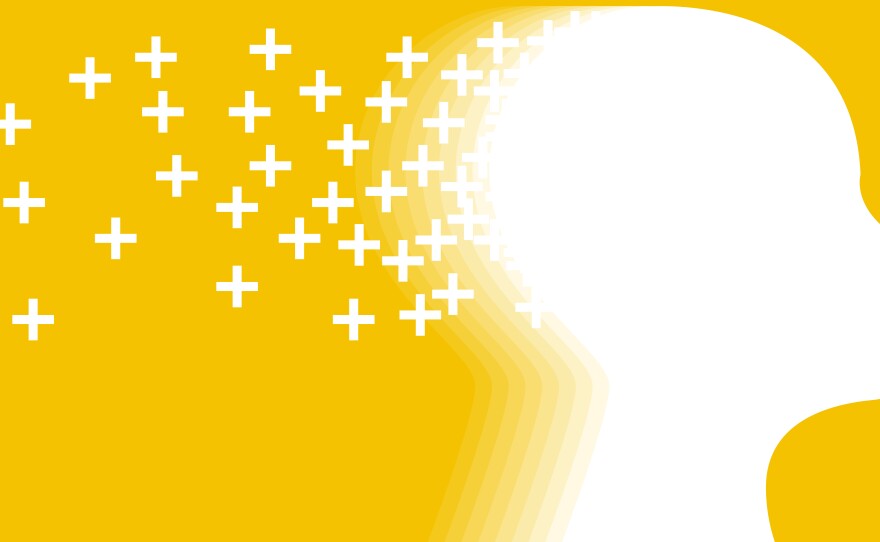In 2004, ABC News correspondent Dan Harris was broadcasting live on the air on Good Morning America when he started experiencing a panic attack.
"My lungs seized up, my palms started sweating, my mouth dried up. I just couldn't speak," he says. "I had to quit in the middle of my little newscast. And it was really embarrassing."
Harris credits meditation with helping him work through the anxiety that caused that panic attack. He went on to write a memoir, 10% Happier, about his experiences with meditation, and he talks about the subject on his twice-weekly podcast. He's also been hosting a daily meditation online with different leaders in the community of people who study and teach mindfulness techniques.
Harris says that meditation is more important than ever during the global pandemic: "I don't think we should sugarcoat it: It's scary," he says. "I've taken to saying, if you're not anxious right now, you're not paying attention."
Though he's been trying to help people quiet their anxiety with meditation and mindfulness techniques, he's careful to note that meditation isn't a "silver bullet" cure.
"Meditation doesn't make the uncertainty go away," he says. "It's not like I meditate and I'm walking through this pandemic like a unicorn barfing rainbows all the time."
Rather, Harris says, meditation allows people to "relax into the uncertainty. ... It just means that you're able to see that the fear — like everything in the world — will come and go, and that if you just relax for a second, and breathe into it, it will come and go."
Interview Highlights
On how a leading meditation teacher recommended the loving-kindness meditation as the best support during this pandemic
I had a very negative reaction to loving-kindness meditation [at first]. First of all, the name itself. I mean, could you come up with anything more treacly? And then it gets worse when you actually hear what the practice entails. So here's how it works: You sit and close your eyes and you envision a series of beings, so people or animals. Classically, you start with yourself and then you move on to a good friend, it can be your pet or kid, some easy person in your life that it's very easy to generate warmth for. Then you move on to a mentor, a benefactor or somebody who's played a positive role in your life. ... And then you move on to a neutral person, somebody you often overlook. And this is a poignant category right now, because the neutral people — the people manning the cash registers at the supermarkets and delivering our food and mail, and the neutral people for many of us that we often overlooked — are saving our lives quite literally now.
Then you move on to a difficult person — not hard to find for many of us. And then finally, all beings. In each case, you summon a mental image or a felt sense of your targeted being, and then you repeat a series of phrases. Usually the phrases are, "May you be happy. May you be safe. May you be healthy. May you live with ease." ...
There's a lot of science that strongly suggests that this practice and its variance can produce really meaningful physiological, psychological and behavioral changes. And if you think about it, this is a radical notion, the idea that warmth, friendliness, kindness, dare I say love — these are not factory settings that are unalterable.
You aren't wired a certain way when it comes to your interpersonal relations and unchangeable. In fact, these are skills that you can develop. And that is such a radical notion, that the mind is trainable. I've been doing this loving-kindness meditation now pretty intensively — including going on long retreats where that's all you do — for several years. And I've found it's made a big difference in terms of my inner weather, and how I relate to my own ugliness, because we all have ugliness.

On the important difference between fear and panic
I'm largely stealing this from a rather brilliant woman I met right at the beginning of the pandemic. The first pandemic-themed episode I did was in mid-March. And one of the guests was a woman named Dr. Luana Marques. She's Brazilian by birth, but now works at Harvard as an anxiety expert. And she told me about something called the — I think this is the right name — Yerkes-Dodson [Law]. You can look this up on Google; it's a bell-shaped curve. And it talks about this sort of utility of anxiety, which is an interesting concept. And it kind of gives us permission to not feel bad about the fact that we're feeling a certain amount of justifiable fear and anxiety.
And so at the beginning of the slope, right until you get to the top of the curve, the anxiety and fear that we may be feeling in the face of this pandemic or anything really, makes sense. It motivates us to act. But then it starts to go downhill. And that's when we tip into not very helpful panic, where we constrict and the physiological response is enfeebling and we're not able to make good decisions. That's when we hoard toilet paper or we're nasty to our neighbors or we spread misinformation on Twitter, whatever it may be. So what we want is to be at the top of the Yerkes-Dodson curve with the appropriate amount of anxiety without tipping in to panic. That is where I feel mindfulness meditation — the kind of meditation with which most people are familiar — that's one of the areas where mindfulness meditation can be really helpful.
On how many people are experiencing vivid dreams during the pandemic
I've been having wild dreams — classic anxiety dreams where I'm trying to get somewhere and I can't get there, or I'm being chased or I'm back in school. This is being reported widely across our culture, across the globe, as I understand it, and I was talking to Dr. Mark Epstein about this. ... I had him on the show originally and I was asking him, why do you think we're having these crazy dreams? And, in typical fashion, he gave the disclaimer that he doesn't really know, but his instinct is that we're "processing." That's what we're doing in these dreams is we're sort of flushing out, purging, processing the — this is his term, not mine — the collective trauma and the collective grief we're all experiencing right now. It can be jarring to have these dreams, but you might look at it as the functioning of a healthy brain and mind.
The key part of meditation is to get distracted, to see the wildness of your own mind over and over and over again, and then to begin again — and again and again.
On how to practice mindfulness meditation
You sit in a quiet enough spot and you then bring your full attention to the feeling of your breath coming in and going out. You don't have to breathe in any special way. This is not actually a breathing exercise. And there's nothing special about the breath per se, we're just picking something south of your neck to pay attention, we're going to get your attention out of the swirling stories in your head and onto the raw data of your physical sensations.
So it can be your breath. For some of us, the breath right now is triggering, given the fact that COVID-19, has pulmonary consequences. So you might want to pick just the feeling of your full body sitting or lying — or maybe your hands touching, or your bottom on your chair, just picking some physical anchor to where you can place your mind and you just kind of commit to it, gently, that I'm going to pay attention to this for one to five to 10 minutes.
That's the second step, and then the third step, the final step really, and this is the most important step — as soon as you try to do this, your mind will go into a mutiny mode. You're going to start thinking about, when can I get a haircut? Where do gerbils run wild? Why did Dances with Wolves beat Goodfellas for Best Picture in 1991? Blah, blah, blah. And the whole game is just to notice when you've become distracted and to start again, and again, and again.
And this distraction, by the way, is not a failure. It is not a malfunction. It is part of the meditation. The key part of meditation is to get distracted, to see the wildness of your own mind over and over and over again, and then to begin again and again and again. ... It is the seeing of the wildness of the cacophony that is really important, because when you see it, it doesn't own you as much.
On why meditation isn't about controlling your mind
It's actually not about trying to tamp down on or control the way the mind works. It's about familiarization. Just getting to know how nutty it is inside your brain, inside your mind, is incredibly important, because when you've tipped over into panic or any other unhelpful, unskillful mind state — like greed or anger or hatred — then you might notice it. And then you have a choice: Am I going to be owned by this panic right now or am I going to be owned by this anger right now? Or am I going to be so controlled by the anger that I'm going to say something that's going to ruin the next 48 hours of my marriage? Or am I going to eat the 75th Oreo?
Having this self-awareness — otherwise known as mindfulness — which is what's developed through the process of seeing your distractions and then beginning again (gently over and over and over again), that is a game-changing skill. Because ... this nonstop conversation ... is a central feature of your life — whether you know it or not, we're all walking around with this inner narrator that if we broadcast loud, you would be locked up. And when you're unaware of this cacophony internally, it's owning you all the time. And what we're doing in meditation is dragging all of this nonsense out of the shadows and into the light.
On why focusing your energy on helping others can quiet the feelings of loneliness and despair during the pandemic
Helping other people puts you back in touch with what is good about you. And it can take you out of the black hole of self-obsession. And those are two really useful benefits of helping other people. It doesn't have to be grandiose. It doesn't have to be giving away all of your money. It can be running errands for your elderly neighbor. It can be checking in on friends. It can be making small donations to charity. It can be volunteering at a safe social distance with local nonprofit groups. There are lots of ways to help out. Adopting a cat, adopting a dog — many, many ways to get you out of the self-obsessed dialogue and put you in touch with your best characteristics, which are helping.
Radio producers Amy Salit and Therese Madden and web producers Bridget Bentz, Molly Seavy-Nesper and Deborah Franklin contributed to this story.
Copyright 2023 Fresh Air. To see more, visit Fresh Air. 9(MDAzMjM2NDYzMDEyMzc1Njk5NjAxNzY3OQ001))






